Lingerie Elastic 3 Ways
A couple of years ago I spent a week making panties from my knit scraps. I was on a real knit kick, making everything from dresses, to tanks, to pajamas. I ended up with a huge pile of knit scraps. I was dedicated to the making the most of these unused pieces of fabric. I ordered several yards of plush-back picot elastic.
This is the type of lingerie elastic I was most familiar with, and thus seemed like the obvious choice.I set to work, drafting patterns and planning fabric combinations, by the time my elastic arrived I was more than ready to get started.
In one afternoon I whipped through 4 pairs of underwear. That is when tragedy struck. I was out of elastic. I drove to the nearest fabric store only to find no picot elastic. This wasn’t going to stop me. I grabbed several yards of fold over elastic and 1/4″ braided elastic.
This happy accident led me to experiment with different elastic applications that I would have otherwise not used. I still like to make use of my scrap pieces of knit fabric by making pretty under-things. These are the three elastic techniques that I use regularly.
Picot Edge Elastic
This is the most widely used lingerie elastic, and with good reason. It is so cute! Picot elastic comes in a variety of scalloped and decorative edges. It is also incredibly easy to use.
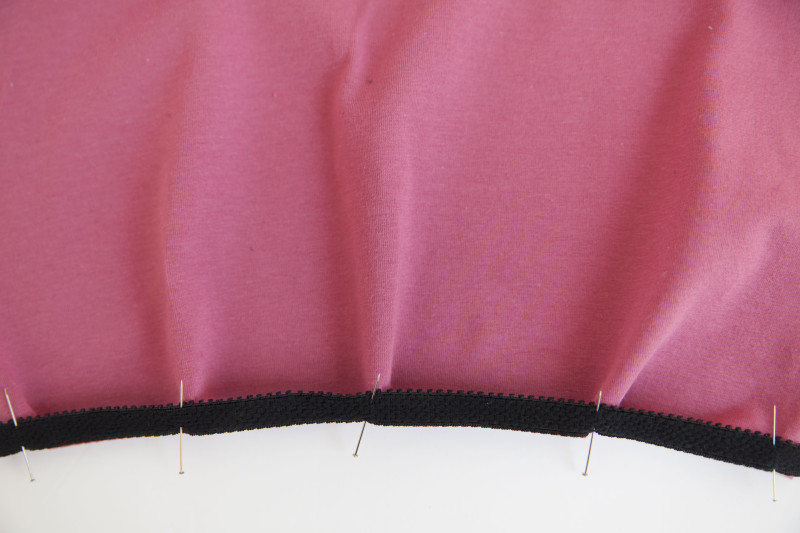
1) Pin elastic to edge of fabric right sides together, aligning plain edge of elastic with raw edge of fabric.
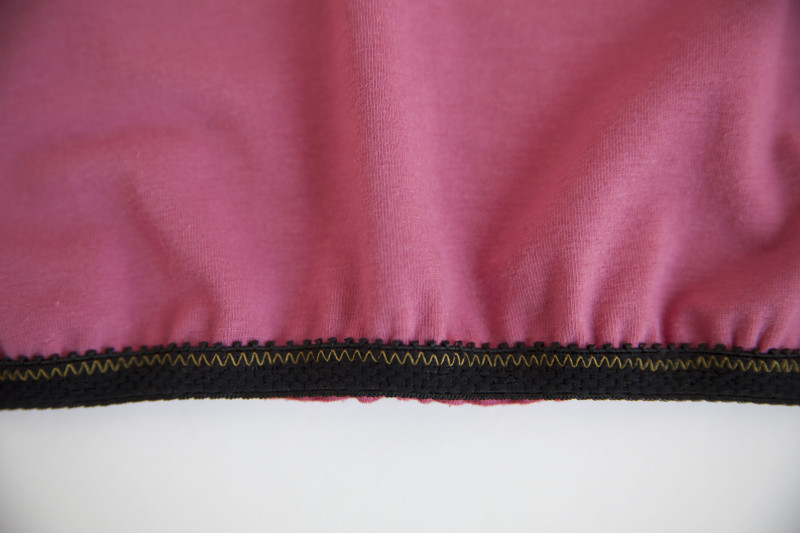
2) Sew 1/8 away from the decorative edge using a zigzag stitch set at length 2 width 3.
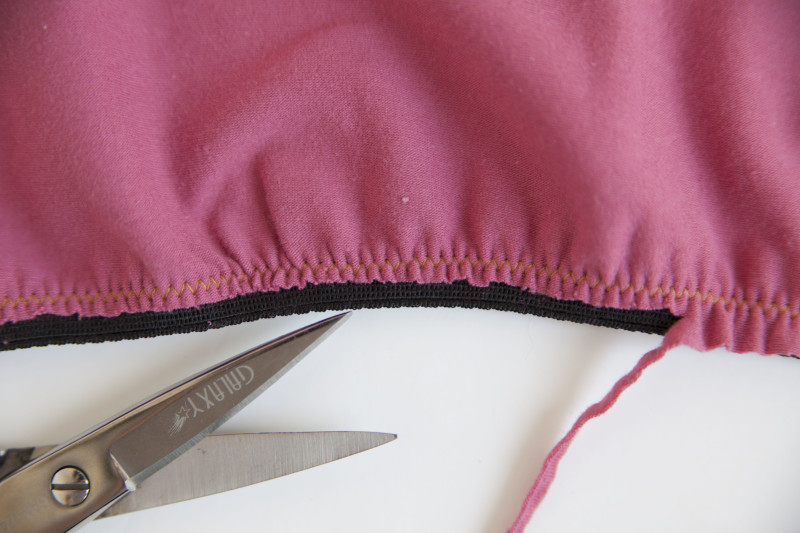
3) Trim excess fabric using small trimming scissors.

4) Fold elastic towards the wrong side of the garment. Topstitch using a 3-step zigzag with a length of 1 and width of 4.
Fold-over Elastic
The results of this technique are both pretty and comfortable to wear. I love using bright colored elastic to liven up a more neutral self fabric. The popularity of fold-over elastic in crafts has made this notion especially easy to get your hands on in recent years.

1) Place fabric and fold over elastic wrong sides together, lining up edge of elastic with the edge of the fabric.
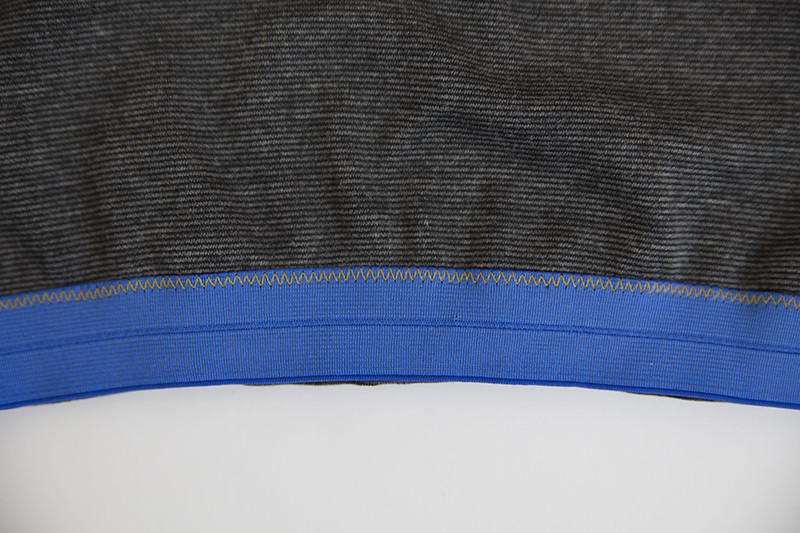
2) Use a zigzag stitch to baste along the innermost edge of the elastic.
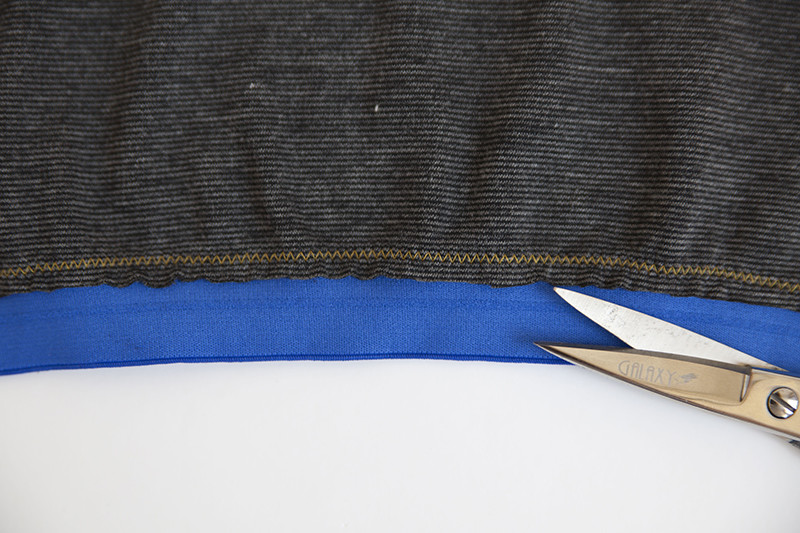
3) Trim back any excess fabric on the right side.
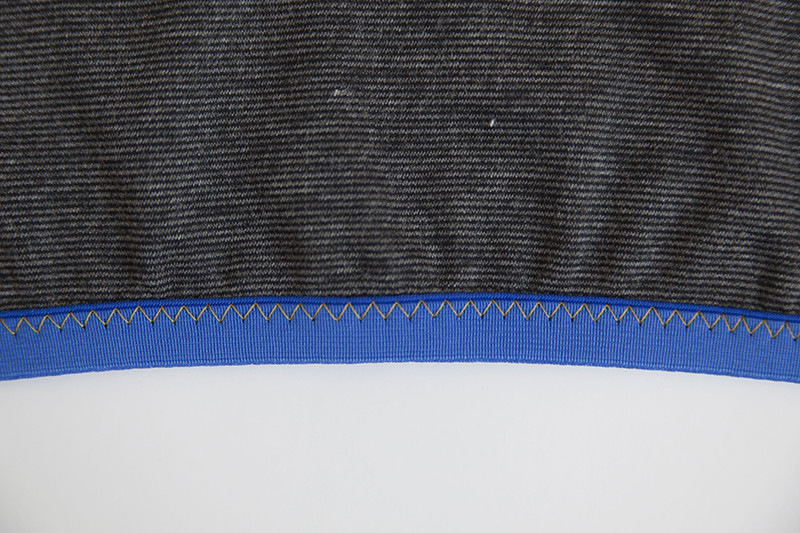
4) Fold the elastic along the fold-line towards the right side of garment. Top stitch using a zigzag stitch.
1/4″ Knit Elastic
This is easily the most accessible technique, given the wide availability of woven and braided elastic, but beware, not all elastic is created equally! Check to make sure elastic is not rigid and stiff before purchasing. My local fabric shop carries swimwear elastic that has a high cotton content. This makes the elastic plush and perfectly suited to more delicate purposes.
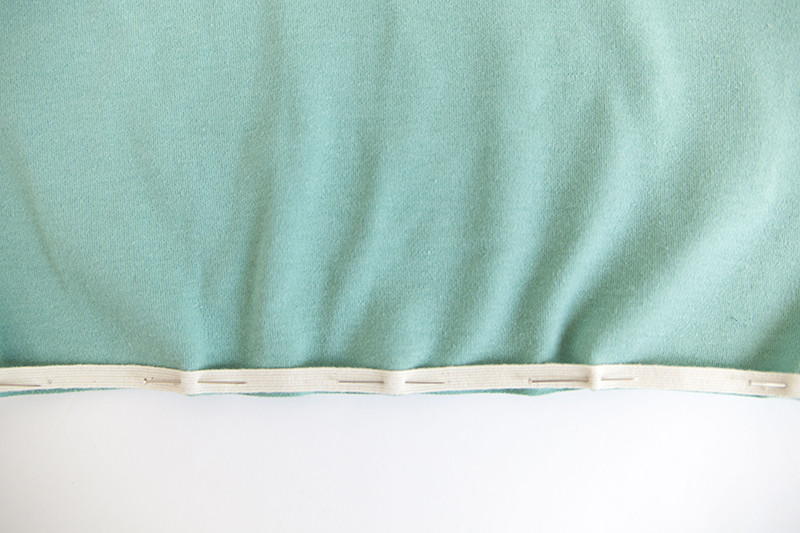
1) Pin elastic to wrong side of fabric, lining the edge of the elastic up with the raw edge of the fabric. Pin along the length of the elastic for extra control.
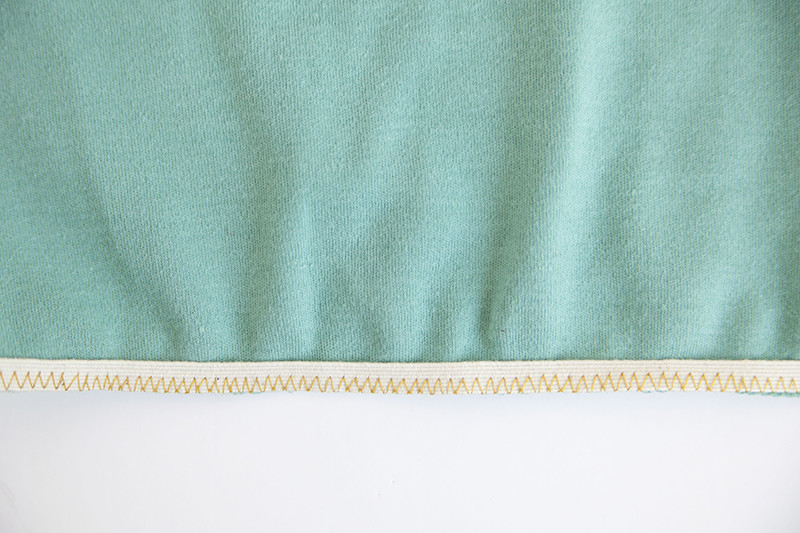
2) Baste elastic to the wrong side of fabric using a zigzag stitch.

3) Fold elastic under, towards the wrong side if garment.
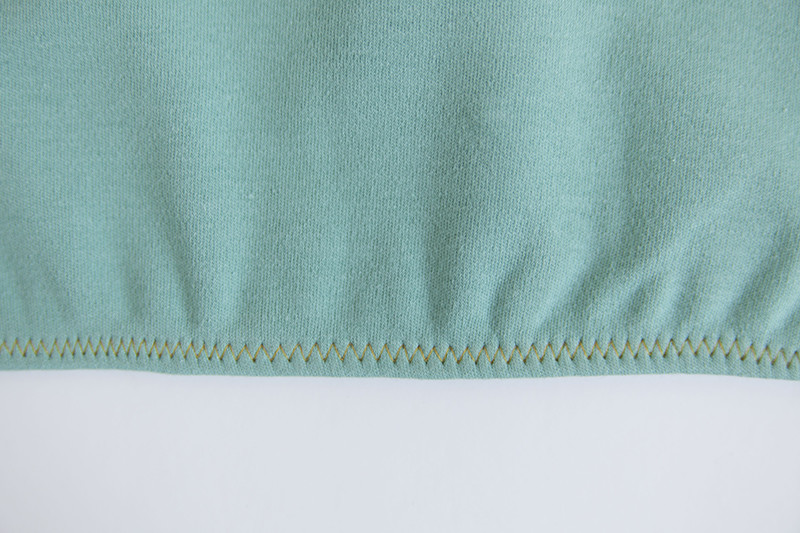
4) Topstitch using a zigzag stitch.
I like that now I have a broader arsenal of lingerie elastic techniques. If I hadn’t run out of elastic that fateful day, I would probably have never experimented with different options. Do you have any sewing crutches? Have you ever learned a valuable sewing lesson when you reached passed your comfort zone?

 Sign In
Sign In


Comments
Amy Draughon
June 30, 2015 #
This is so great! I have never tried lingerie sewing before, mostly because I was confused about types of elastics and how to sew them on. Thank you for this post!!
tillie pult
July 1, 2015 #
Howdo I measure the amount of elastic I need?
Haley
July 1, 2015 #
I like to wrap the elastic around area the waistband will fit, then reduce by 1″ or 2″ depending on the elastic and it’s recovery. I use the same technique for the leg holes as well.
Miss Crayola Creepy
June 30, 2015 #
I love this post, Haley! I have saved all of my knit scraps and want to do the same thing. Thank you for the tips and motivation. High five!
Also, the new site looks great!
Haley
June 30, 2015 #
It is a stupidly gratifying project! I highly recommend it. Thanks for all the support!
Becky
June 30, 2015 #
I love the new website design! Very clean and consistent across the different sites and well organized.
I was inspired to convert a dress I made (and didn’t end up liking) into a skirt yesterday. While looking through my mending bin, I discovered a bunch of old t-shirts I’ve saved for exactly this! And now that I don’t have to worry about finding the exact right elastic, the project might actually happen. Thank you!
Schmam
July 4, 2015 #
Old cotton t-shirts make the BEST panties! I discovered this by using them to muslin different panty patterns. I also use them to cut the cotton crotch liner for those made using other fabrics.
Becky
July 5, 2015 #
Awesome, thanks! I had forgotten about the liners – not having made any underwear yet – but now I’m very happy I stashed my old tees for later (re)use. My future handmade wardrobe now seems just a little bit more achievable!
Kyema
June 30, 2015 #
Great article! So as far as the FOE goes, do you use it for the waistband and the leg holes? I made a pair for my sister but I actually folded it over and got that it wasn’t that comfortable around the legs, wondering if leaving it unfolded would be okay for the legs as well as the waist. Thanks!
Haley
July 1, 2015 #
Hi Kyema, FOE can vary in quality and thickness. With more substantial FOE you could definitely leave it unfolded for a smoother finish.
erin
June 30, 2015 #
Thanks for this wonderful explanation, your method is much better than what I have been doing so far! I will definitely use your method in future, it will ensure better looking elastic sewing :)
Francesca
July 1, 2015 #
First of all, new layout was a shock at first as I loved the old site, but it’s ultra clear and pretty now i’m used to it – congrats!
secondly – I’ve been making knickers for quite a while, both in knit and in woerns, love picot elastic, and have used both normal and foldover.And i really wish this was around when I started! nice tute:). i just wanted to add a cool tip i picked up from Madalynne – to give the elastic a few good stretches before using it. Also, I have found that even though you may find good knitted elastic, always check your length against your body! I made a few panties which were so comfy, ran out of knitted elastic, went and bought more 3/8″ which seemed the same, cut my same measurements and ended up with twingy elastic. Grrr. and such a hassle to unpick two rows of zig zag!!!
Nadia Létourneau
July 1, 2015 #
I really enjoyed the post, wery clear and seem doable easilly. I will definitivelly give a try in all this techniques!
Thank you very much Haley
Ava
July 1, 2015 #
Perfect. Just wanting to make long slips for under too thin maxi dresses. Now where do I find fabric for slips?
Haley
July 1, 2015 #
I like using silk jersey, which I have purchased from Mood in the past.
Donna
July 1, 2015 #
I’ve noticed that the stitching is very close to the edge of the jersey. What’s a good way to keep the fabric from getting sucked into the machine and the thread getting all knotted up?
Haley
July 1, 2015 #
Holding onto the tails of your thread when you begin stitching can be really helpful. I also alway favor sewing a bit away from the edge of the fabric, and then trimming. This is the technique I used to stitch the FOE and picot elastic.
Diane O
July 1, 2015 #
Talk about perfect timing…I was getting ready to use fold over elastic, and found it a bit intimidating. After seeing this, and the way you have it shown looks like a breeze. Thank you!
Joyce
July 1, 2015 #
Would you mind doing a tutorial on drafting undie patterns or could you tell us about someplace to find patterns for bloomers. I too have a stash of knits that need thinning out. Thank you for this tutorial. I have wondered for some time the best elastic for undies.
anastasia legatos
July 1, 2015 #
Hi Haley!!!
This is so inspiring and it’s making my wheels turn and look and see what knit scraps I have left over to make into lingerie :) I am fairly new to sewing but I have seen lots of FB posts of undergarments that are using ribbed knit instead of elastic. What are your thoughts about it?
Haley
July 2, 2015 #
I prefer elastic for the waistband otherwise I find that my underwear will not stay put. I think that using ribbed knit to finish the leg holes would be a great option, and would provide lots of fun mixing and matching options!
Laura
July 1, 2015 #
I love the finish of lingerie elastic for knit dresses too. I just made a sleeveless Moneta finishing the neckline and arms in black picot edge elastic.
Joanna
July 2, 2015 #
Thank you, this was just the article I needed! I am enjoying exploring making underwear and a bit fed up of having to keep ordering picot on line because none of my local haberdasher use stock it, now I can keep going using elastic I can buy from the supermarket and it is still a pleasing finish!
Sylvia
July 2, 2015 #
I really enjoyed this article on the elastic application. I tried to replace elastic in a pair of undies. I have one question. How do you measure the elastic? I used 4 inches smaller than my waist. My application was wit the picot elastic, but it turned out bad. It was too little for the panties, it gathered up terribly. So, can you tell me what to do to have the proper size elastic?
Haley
July 6, 2015 #
I like to wrap the elastic around area the waistband will fit, then reduce by 1″ or 2″ depending on the elastic and it’s recovery. If an elastic is particularly relaxed then I might reduce by 3″. I use the same technique for the leg holes.
Rachel
July 2, 2015 #
Super helpful, thank you!
Sky Turtle
July 3, 2015 #
Great post! I only tried the 1/4 knit elastic and couldn’t figure out what went wrong, but now that you mention it, I do think the elastic was too rigid. Also, it’s great to see all techniques on the same page, very useful!
Christine
July 8, 2015 #
Delighted to see I’m not alone in making my own knickers from remnants! I posted a blog about it couple of days ago using elastic lace much the same as your first method. So simple and looks great.
Van
July 14, 2015 #
Thank you for this! I’ve been meaning to use my knit scraps to make panties, but was daunted by how much elastic I’d have to sew on the finishings. Now I’m going to go home and give all these tips a try.